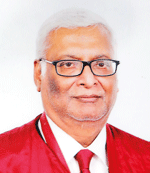The little known Green Hospital of Sri Lanka
View(s):Taking up the mantle of the CCP in the year of its golden anniversary with his fitting theme, ‘Celebrating our Past, Igniting our Future’ is Consultant Physician Dr. S.D. Jayaratne.
“Since its inception in 1967, the CCP has acted in the capacity of an academic body which advocates the improvement of standards in postgraduate education in medicine, promotes continuous professional development and learning, ethical conduct and research, to enhance professional standards in clinical practice,” he says.

Dr. S.D. Jayaratne
Flipping back the pages of time, Dr. Jayaratne refers to ayurvedic medicine which was in place before the introduction of western medicine by the Portuguese in the 16th century. “Exorcists apparently made a considerable income, so much so that the king imposed a separate tax on them.”
The colloquial term ‘ispirithal’, however, has been derived from Portuguese. There were only four hospitals at the time — Colombo, Mannar, Jaffna and Galle, in the cities where the Portuguese based their garrisons and treatment was only for the Portuguese. The Colombo hospital was situated near the present day harbour, he says, adding that doctors received two rice rations and a ‘curry allowance’ every day, while taking home additional ‘gifts’.
Pulling out sepia-toned photographs of the Green Memorial Hospital in Manipay, Dr. Jayaratne says that it was also the first medical school in the country set up by the American missionary, Dr. Samuel Green, in 1850, which is still standing.
“This is actually a little known fact of our medical history. More than 60 locals had been trained here over 30 years. The first batch had just three hand-picked students, locals who worked for the mission. The course lasted three years and was based on the curriculum of the American universities at the time.”
The 19th century saw just three hospitals for civilians, the Hendala hospital for lepers, the Pettah hospital for paupers and the Borella lunatic asylum.
According to Dr. Jayaratne the first batch of medical students to receive formal training completed their course in Calcutta, India, and included Dr. W.R. Kynsey, who went on to become the first President of the Ceylon Branch of the British Medical Association, which later became the SLMA. The Colombo Medical School was established in 1870, with three teachers and 25 students initially, and became part of the University of Ceylon in 1942.

Manipay’s Green Memorial Hospital staff in the days of yore


